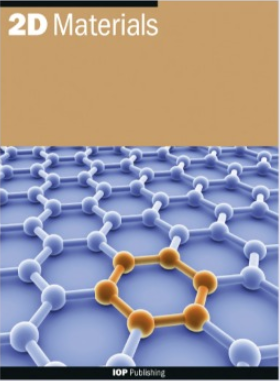Metal-metal bonding, electronic excitations, and strong resonance Raman effect in 2D layered α-MoCl3
IF 4.3
3区 材料科学
Q2 MATERIALS SCIENCE, MULTIDISCIPLINARY
引用次数: 0
Abstract
Abstract Covalent bonding between transition metal atoms is a common phenomenon in honeycomb lattices of layered materials, which strongly affects their electronic and magnetic properties. This work presents a detailed spectroscopic study of α-MoCl3, 2D van der Waals material with covalently bonded Mo2 dimers, with a particular focus on the Mo–Mo bonding. Raman spectra of α-MoCl3 were studied with multiple excitation laser lines chosen in different parts of the absorption spectrum, while polarization measurements aided in the symmetry assignment of the observed modes. Furthermore, far-IR measurements and DFT phonon computations were performed to complete vibrational assignment. Polarized absorption, photoluminescence, and photoelectron spectroscopy supported by DFT calculations were employed to understand the consequences of the Mo–Mo bonding for the electronic structure and the localization/delocalization balance in d3–d3 interactions. A coupling of dimerization-related structural and electronic properties was revealed in the strong resonance Raman enhancement of the Mo–Mo stretching mode at 153 cm−1 when the excitation laser matched the electronic transition between σ-bonding and antibonding orbitals of the Mo2 dimer (σ→σ*). The deeper understanding of the metal-metal bonding and identification of the vibrational and electronic spectroscopic signatures of the dimerization will be of great use for the studies of electron delocalization in magnetic van der Waals materials.二维层状α-MoCl3的金属-金属键、电子激发和强共振拉曼效应
摘要:过渡金属原子之间的共价键是层状材料蜂窝晶格中普遍存在的现象,它强烈地影响着层状材料的电子和磁性能。本文对具有共价键合Mo2二聚体的二维范德华材料α-MoCl3进行了详细的光谱研究,特别关注了Mo-Mo键。研究了α-MoCl3的拉曼光谱,在吸收光谱的不同部分选择了多条激发激光谱线,偏振测量有助于观测模式的对称分配。此外,还进行了远红外测量和DFT声子计算来完成振动分配。利用DFT计算支持的极化吸收、光致发光和光电子能谱来理解Mo-Mo键对d3-d3相互作用中电子结构和局域/离域平衡的影响。当激发激光匹配Mo2二聚体的σ键轨道和反键轨道(σ→σ*)之间的电子跃迁时,在153 cm−1处Mo-Mo拉伸模式的强共振拉曼增强中揭示了与二聚相关的结构和电子性质的耦合。对金属-金属键的深入认识和二聚化过程的振动和电子光谱特征的识别,将对磁性范德华材料中电子离域的研究具有重要意义。
本文章由计算机程序翻译,如有差异,请以英文原文为准。
求助全文
约1分钟内获得全文
求助全文
来源期刊

2D Materials
MATERIALS SCIENCE, MULTIDISCIPLINARY-
CiteScore
10.70
自引率
5.50%
发文量
138
审稿时长
1.5 months
期刊介绍:
2D Materials is a multidisciplinary, electronic-only journal devoted to publishing fundamental and applied research of the highest quality and impact covering all aspects of graphene and related two-dimensional materials.
 求助内容:
求助内容: 应助结果提醒方式:
应助结果提醒方式:


